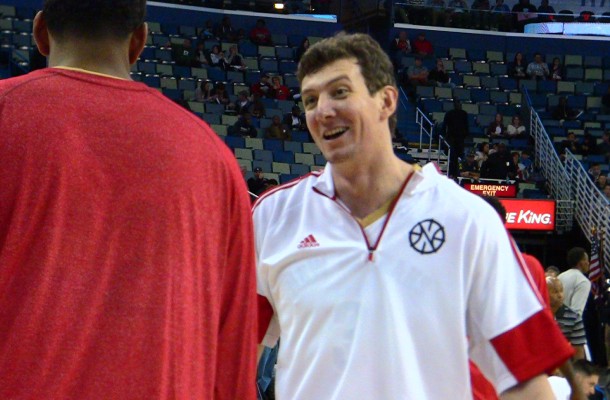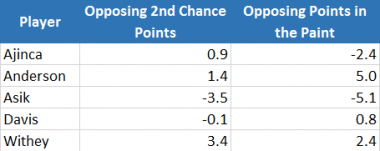« In the NO Podcast Episode 205: Trades!
Optimizing Omer: Part 2 »
Optimizing Omer: Part 1

How quickly we forget. After consecutive seasons of atrocious defense, the Pelicans are in the midst of a defensive revival. It’s not that they’re fantastic – they rank 21st in Nylon Calculus’s defensive efficiency rankings – it’s that they are far better than they were last year, particularly when they play their better units. Yet much of today’s discussion seems to revolve around the shortcomings of Omer Asik. Some of these assertions were already refuted by Nick Lewellen in January.
It seems somewhat natural to use Asik as a scapegoat for our recent problems. Because when Asik misses, he misses. Though Asik’s shots rarely come from further than 2 or 3 feet away, he has a tendency to miss.. and miss badly. His FG% doesn’t reveal this offensive deficiency, but he is a low-usage player who misses a lot of gimme putbacks and layups. The kind of misses that you don’t expect of your high school basketball buddies, much less an NBA player. The kind of misses that want to make you rinse your eyes. And opposing defenses are fully aware of this deficiency in Asik’s game, and you better believe they are taking advantage of it: teams regularly leave Asik open in order to stop other Pelicans. This is part of the reason why Asik is such a terrific offensive rebounder: it’s easy to carve out position on the O boards when you are boxing out no one.
The truth is that Omer Asik was brought in for three specific reasons, and he is filling all 3 of those roles.
1. To shore up the defense around the basket
Remember the days that opponents could waltz to the rim for easy layups? Those days are over. Though the Pelicans defense seemingly fails them in the waning moments of tight games, the defense in the restricted area has been significantly better this season.
There are 2 notable areas of improvement here: the opposing percentage in the restricted area and the number of free throws attempted per 48 minutes. Some would point to the increased volume of shots in the restricted area as a negative, but I have always been of the belief that perimeter players/scheme are more influential in allowing players to get to the paint. And Omer’s reign extends to all of the paint, not just the restricted area, as evidenced by these differential stats (per 48).
These differentials were calculated by subtracting the Pelican per 48 defensive totals with the player off the court from the per 48 defensive totals with the player on the court. For example, the Pelicans allow 42.9 points in the paint/48 min with Asik on the court and 48 PITP/48 with him off. The difference (-5.1) is what you see in the table, and it means that the Pelicans surrender far fewer points in the paint when Omer Asik is in. This is not a “perfect” stat by any means, as any on/off metric has a variety of issues that can be mitigated by fancy math I have not learned yet. But at a quick glance, Omer’s defensive impact seems to have a tangible effect in both preventing good shots and preventing 2nd chance points.
And that’s the thing. You don’t see Omer’s defensive impact in a traditional box score, because he doesn’t block that many shots. Playing good defense extends far past shot-blocking, though, and Omer’s ability to go straight up without fouling is highly valuable: players don’t get to the line as much and they also have to take more difficult shots. These are highly valuable skills that seem to be ignored when naysayers cite Omer’s “average” defense. I don’t think Omer is necessarily the defender he was in Chicago or in his first year in Houston, but if you think Omer isn’t a very good defender, you aren’t watching closely enough.
2. To shore up the rebounding
There are few things more frustrating than having a good defensive possession and then losing a rebound to the other team and wiping away all of your hard work. And the Pelicans struggled mightily in both areas during the 13-14 season: they couldn’t stop anyone and they also couldn’t finish a defensive possession with a board even if they did.
Omer Asik’s presence has changed both of those things. Though clearly not blessed with very good hands, Omer’s size, instincts, and work rate have had a substantial impact on the Pelican ability to grab boards on both ends of the floor. To date, Omer ranks 5th in the league in total rebound rate, and that’s if you include recently fine-tuned vacuum Hassan Whiteside in the rankings. Omer is a monster rebounder on both ends of the floor.
3. To protect Anthony Davis
The direction that the NBA is moving in is one that highly values speed/quickness, mainly because today’s game is far more perimeter-oriented than the NBA game that our parents grew up watching. To be slow is to die. So it appeared entirely rational to believe that Anthony Davis would be better served playing the 5, as he could terrorize opponents with his end-to-end speed and mobility in the half-court setting. It’s one of the things that fans/analysts criticized Monty for most. They wanted Davis at the 5 and they wanted it now.
But like many criticized decisions in basketball, there was a behind-the-scenes reason for this: Anthony Davis didn’t like playing the 5. And why would he? He was 215-230 pounds in his first two seasons. On most nights, he didn’t belong in the paint. So the Pelicans brought in Omer Asik, a true center who could bang in the post (on defense, obviously) and mitigate the burden on Davis’s still-developing body. That is Omer’s most important role – not to defend, not to rebound, but to protect the present/future of this franchise. Everything else is just gravy on top, and as outlined above, there is plenty of gravy.
I will release Part 2 of this sequence (no spoilers) in a few days. I figured it would be better to keep the content to 2 medium-sized articles (instead of one gigantic one).








Pingback: Today's Best NBA Reporting and Analysis